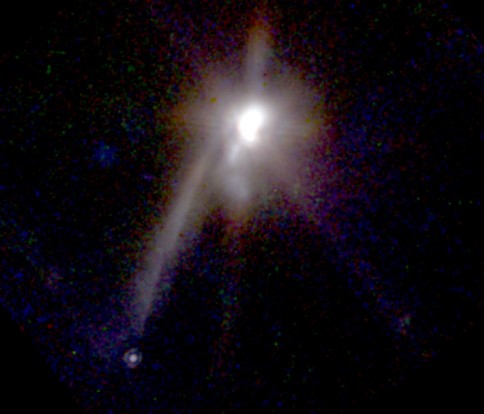
|
Credit: S. Terebey
Extrasolar Research Corp.,
NASA
Explanation:
This infrared Hubble Space Telescope view may contain the first ever
direct image of a planet outside our own solar system.
The picture shows a very
young double star located about 450
light-years away toward
the constellation of Taurus.
Cataloged as TMR-1 (Taurus Molecular Ring star 1),
the binary system is still
embedded in the dust cloud that formed it.
This double star and dust cloud are the brightest grouping in
the picture, glowing strongly at infrared wavelengths.
A filament extends from the binary system toward the lower left and
points toward the spot of light representing the
candidate planet.
Astronomers believe this
planet is a "runaway" object which was
gravitationally ejected, the filament tracing the path to its present
location at about 1500 times
the Earth-Sun distance from the parent star system.
Models suggest that the planet and
binary system are
a mere 300,000 years old, with the
planet having a mass of about 2 to 3 Jupiters.
Future observations to look for the planet's
continued runaway motion
and spectral signatures should be able to confirm
the nature of this object.
While this and other
tantalizing discoveries of
extrasolar planetary objects and
protoplanetary disks
don't seem to offer direct
examples of solar systems
like our own, they do strongly hint
that planet formation is a varied and common process.
Update:
TMR-1 likely just a background star.
|
January February March April May June July August September October November December |
| ||||||||||||||||||||||||||||||||||||||||||||||||
NASA Web Site Statements, Warnings, and Disclaimers
NASA Official: Jay Norris. Specific rights apply.
A service of: LHEA at NASA / GSFC
& Michigan Tech. U.
Based on Astronomy Picture
Of the Day
Publications with keywords: extrasolar planet - planet formation
Publications with words: extrasolar planet - planet formation
See also:
